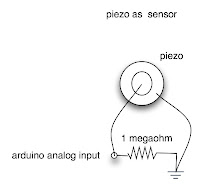Tuesday, 26 October 2010
Max MSP Live Looper
Throughout researching videos on youtube that combined both a performance and technology aspect, I found this interesting video which has been posted from a user named Seamsmusic. Within this, Seamsmusic has created a patch using the software Max MSP which randomly loops live audio which has been taken from the condenser microphone, this audio information is randomly looped within given parameters which adds a textural slutter effect.
When both singing and playing the guitar into the condenser microphone, the patch created in Max MSP takes this information and produces a robotic stutter which adds an interesting effect to a live performance. From this, after watching the video above, I would like to experiment more with live audio and Max MSP to create a patch similar to Seamsmusic. Inevitably, if I was to develop an idea that includes both live audio and Max MSP I would want to use this in a performance aspect; possibly having a band performing and using microphones that are connected to a patch within Max 5?
Wednesday, 13 October 2010
Korg Nano
In today's Performance Technology class, we began experimenting with varied controllers along with Max 5 which enabled us to create interesting patches and use the controllers to their full potential. From this, I choses the Korg nanoPad and began experimenting with this along with max MSP.
 |
| Korg nanoPad |
The Korg nanoPad, is a Midi controller featuring 12 highly responsive trigger pads and additional X-Y touchpad with roll and flam functions for realistic drum programming. USB powered, the nanoPad's X and Y touchpad will send MIDI control change which makes it a useful interface for any parameter when using a software that requires full range MIDI control such as pitch, cutoff, volume etc
The patch below is a working progress and is the result of todays work when I began using the nano Pad along with Max5, as result of this, the patch that I have created assigns each of the 12 trigger pads an individual note through using the note in, strip note and pack objects. As a result of todays work, I feel that I have managed to create a very basic patch that works coincide with the nanoPad however, from this I am going to develop the patch that I have created and use the nanoPad to its full potential.
Tuesday, 12 October 2010
Max MSP Algorithmic Patch
After beginning to use Max 5, the patch above is one of the first patches that I have created within my Performance Technology class with help from the tutorial video and the result of this is that the patch produces a random drunken melody.
Revolving around the "drunk" object in the centre of the patch, the button above this sends a bang to the drunk object which produces a note that will randomly leap each time when pressed. These leaps are determined from the number 4 within the drunk object and this creates a range for the leaps to jump from, this particular range is from -3 to 3. As well as this, the number 128 within the drunk object determines the note range and this can be altered determine the range where I would like my melody to be created. Furthermore, through the use of the "metro 500" object; this object ticks continuously every 500 milliseconds and creates a rhythmical feeling to the patch which ultimately enables the Max 5 patch to create a randomly drunken melody.
From this; designed as a melody maker, this patch allows the user to create unique and random melodies through the process of connecting relative objects together
Tutorial Video taken from the user scje's channel on youtube.
Water Drum Kit
After using the visual programming software Max MSP within Performance Technology, I began searching through youtube to see if and how people are experimenting with this software? Furthermore, as a result of this, I should hopefully be aware of the possibilities that Max 5 will have upon my creativity, thus, this will be able to inspire me to create and develop possible ideas through using this software.
 |
| Piezo Sensor |
Ultimately after only using Max 5 for a short amount time, I do not fully understand how yopayet managed to create this virtual instrument, however through emailing the youtube user and asking for information upon this video I should be able to gain information on this. As well as this, through learning about Max 5 and the the vast capabilities that this software has to offer, I will be able to create patches and connect electronic devices to this software to create interesting sounds.
Subscribe to:
Comments (Atom)

